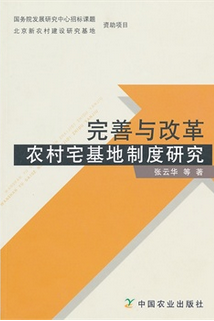Research on Improving and Reforming the Rural Homestead System
2015-10-21
 |
| Research on Improving and Reforming the Rural Homestead System |
By Zhang Yunhua, Research Department of Rural Economy of DRC
A homestead is a farmer's shelter for settlement. The rural homestead system directly involves farmers' immediate interests and is crucial to the economic development and social stability in rural areas. Since the founding of New China, China's homestead system has gradually developed into a set of institutional frameworks with Chinese characteristics. The main content and features of China's property right system and management system of rural homesteads include "owned by the collective, used by farmers, one homestead and two systems, one homestead for one household, welfare-based distribution, free use, free reclaim, limited transfer, no mortgaging and no developing".
China's rural homestead system ensures that farmers have houses to live in, entitles farmers to the fundamental and important residential welfare, and fosters the stable social and economic development in rural areas. However, since the beginning of this century, great changes have taken place in China's socio-economic circumstances: the economy develops at a high speed, urbanization and industrialization advance rapidly, and rural population migrates on a large scale to cities, towns and developed regions. Therein arise some conflicts and problems regarding rural homestead and the homestead system can no longer meet the needs of developing conditions. 1. The collective ownership of homesteads is obscure and the right of collective homesteads is weak. 2. The powers and functions of farmers' usufructuary right of homesteads are incomplete and it is difficult to share the incremental benefits of homesteads. 3. Transfer of homesteads is prevalent and the policy of confining transfer is merely formalistic. 4. The "house-homestead relation" is handled improperly and farmers' housing property rights are incomplete. 5. The problem that homesteads are idled and wasted is serious and the policy of free reclaim is an institutional factor. 6. Pilot projects of mortgaging rural houses spring up and laws stating that homesteads cannot be mortgaged are challenged. 7. The development of "houses with limited property rights" persists despite repeated prohibitions and the policy of prohibiting development is in name only. 8. "Demolishing houses and enclosing land" is spreading and farmers' are facing increased individual and social risks.
The present research believes that efforts should be made to further improve and reform the homestead system in the following aspects: 1. Enforcing the property rights of collective homesteads; 2. Enriching farmers' usufructuary right of homesteads; 3. Relaxing control over the transfer of the right of use where conditions permit, entitling farmers to complete housing property rights, and setting up a market for the transfer of rural houses; 4. Establishing the homestead withdrawal system with compensation and the system of differentiated use of homesteads with compensation; 5. Launching pilot projects of mortgaging rural houses and homesteads; 6. Allowing collective construction lands into capital markets and regulating the arrangement and exchange of homesteads.
This book comprises a general report entitled "Approaches and Policy Options on Improving and Reforming the Rural Homestead System" and 15 sub-reports and case studies including "A Comprehensive Review of Researches on Homestead System", "Evolution of New China's Laws, Regulations and Policies of Rural Homesteads", "Research on Establishing the System for Transferring the Right of Use of Rural Homesteads", "Properly Handle Rural House-Homestead Relations and Fully Entitle Farmers to the Property Rights of Rural Houses", "Positively Explore the Possibilities of Farmers' Withdrawal from Homesteads with Compensation" and "Analysis of the Problem of Farmers' Houses and Homesteads" as well as two appendixes.














